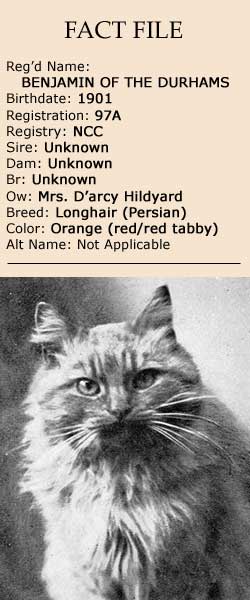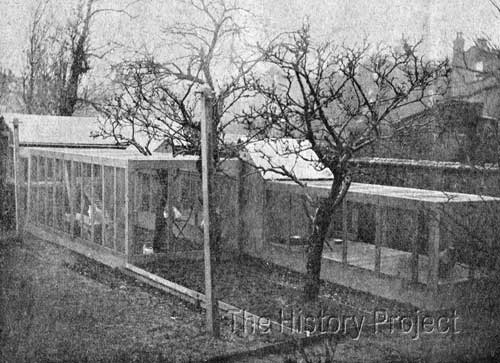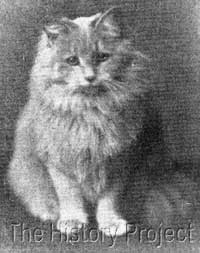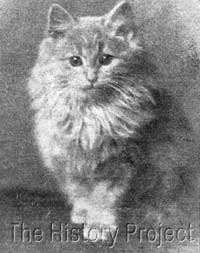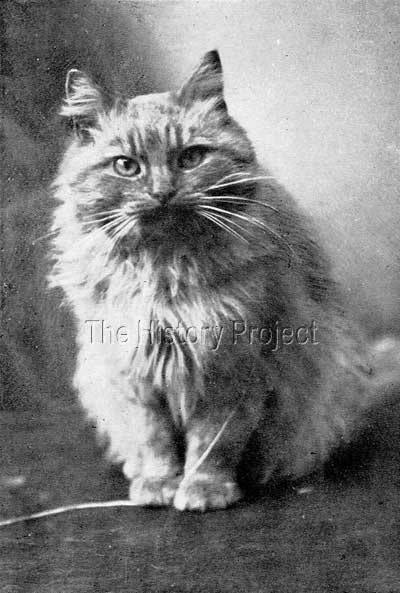 | |||||||||||||||||||









|
BENJAMIN OF THE DURHAMS (1901)PHOTOS | SOCIAL MEDIA | REFERENCES
HISTORICAL BACKGROUND:'Benjamin of the Durhams' was one of only a few well-known English 'Orange' (Red) Persian males at the beginning of the new 20th century. His owner, Mrs. D'arcy Hildyard was better known for her Creams, in which she specialised, producing such famous cats as 'Matthew of the Durhams' and 'Miriam of the Durhams' before being bitten by the bug to breed and specialise in 'Orange' cats. She began her interest in reds by breeding her Cream queen 'Josephine of the Durhams' to Mrs. Neate's orange male, 'The King's Own' and from this she produced two rare red females, 'Mehitabel of the Durhams' and 'Glory of Prittlewell'. The first photograph of 'Benjamin' is that by Burgess, of Market Lavington, which first appeared in Our Cats magazine, on 20th December 1902 and was subsequently republished in Frances Simpson's classic work The Book of The Cat in 1903 in her chapter on Orange Persians. The main difficulty for breeders of 'orange' long-hairs was to produce a cat without barring. Most of the first oranges were red tabbies but seldom with good patterning. Over time, breeders selectively bred them to reduce the effect of barring, much in the same way as breeders for Shaded Silvers selectively bred for coat clarity and the removal of any sign of tabby. In her chapter on 'Orange Persians' Miss Simpson gives the Standard of Points for 'Orange Self or Tabby' and then explains: "It will be noticed that the heading of these points is 'orange self or tabby'; but as I have pointed out, the cats exhibited as orange Persians are neither self-coloured nor can they be called tabby. So it remains to be see which type of cat will in due course be the established one. I incline towards a self-coloured orange in the Persian breeds, and a very handsome cat this would be - of just one tone of bright even colour, perhaps slightly lighter on the flanks and stomach, under the tail, and with a frill of a paler tone. In fact, very much the type of a smoke cat, in two shades of brilliant orange. At the same time, if real orange tabbies can be bred with the distinct body markings these should be encouraged."4 PARENTAGE & OWNERSHIP:
Unknown
Unknown
| Unknown
Benjamin of the Durhams, 1901, Orange M
| Unknown
Unknown
Unknown
There is regrettably, no surviving information about 'Benjamin's' breeding and no exact date of birth, although it is known he was born some time in 1901. However, an article published in Our Cats magazine on 28th February 1903, which includes a precis on Mrs. Hildyard's cats, does give us an insight into how he became her property and why he has no known pedigree. Mrs. Hildyard had formed strong friendships with both Mrs. F. Neate, owner of the Orange male, 'The King's Own', and Mrs. Woodcock, mistress of the 'Of Wigan' cattery. At the time the article was written, Mrs. Hildyard was on a customary winter holiday, and staying with Mrs. Woodcock and boarding all her cats in Mrs. Woodcock's new boarding facility at Southport.
The article was based on a visit to that property and provided a wonderful photograph of the luxurious accommodation afforded the inmates of the cattery. From that article we have gleaned this critical and humorous anecdote:
"Benjamin, the only gentleman in that creamy-tawny cattery, should certainly sing 'My face is my fortune'. He was bought by Mrs. Neate for a song, a pedigree-less cat. Mrs. D'arcy Hildyard bowed to the demands of this very sweet face, purchased him and declares she has been trying to get rid of him ever since. I ask you candidly, does she look as though she were very anxious to do so? He is a most fascinating fellow, with a charming face, short nose, and well-shaped head. He is not perfect, but that is not his role. He leaves that to Miriam. He has proved himself an excellent sire - witness the beautiful litter by him at the last kitten show. "We made no enquiries as to how long Mrs. Hildyard intended to stay in her present pleasant quarters, but can only offer our congratulations to any fancier who can induce Mrs. Woodcock to give her and her cats change of air, in sunny, dry, and cheerful Southport."2 SIBLINGS & SHOWS:With no known heritage, there is no opportunity to trace siblings. Of shows, there is only one award recorded, a third prize won at Manchester. This also appears in his stud advertisement, published in 'Our Cats' in March 1903. BREEDING & PROGENY:'Benjamin' does have a good history as a working stud. But he was used almost exclusively by Mrs. Hildyard in her quest to produce reds. She believed that to produce a good red, you needed to use Creams as the best viable outcross, which is why she bred her cream queen, 'Hazeline of the Durhams' to Mrs. Neate's orange male, 'The King's Own' to produce both 'Mehitabel of the Durhams' and 'Glory of Prittlewell'. Once she had bred red queens in this fashion, they were then bred back to 'Benjamin' to secure more reds of both sexes. Her views and experiences, as well as those of Mrs. Neate, are recorded in their own words, by Frances Simpson. Mrs. Neate had this to say about the breeding of orange cats: "It is most difficult to breed oranges without white lips and chins; the pink nose, too, is a feature in the breed that I do not like. I have found crossing an orange male with a cream female the surest way to breed sound-coloured specimens of both sexes and varieties, e.g. 'Mehitabel of the Durhams' ( a really rich coloured unmarked orange queen, and quite free from the objectionable light shading on lips and chin); she was bred by Mrs. D'Arcy Hildyard from her cream female 'Josephine of the Durhams' and 'The King's Own'."4 Mrs. D'Arcy Hildyard then enlarges on the subject, from her own experience: "Until comparatively lately I confined myself entirely to the breeding of creams, and my efforts were attended with considerable success, both in multiplying the cats of that colour - I bred thirteen one year - and in filling the classes given for cream females. I was particularly lucky in breeding many creams of the gentler sex.
"The birth of the Orange and Tortoiseshell Society fired me with ambition to start breeding oranges. I was much fascinated with the colour, though I hate them being penned beside the creams at shows, as they completely take all colour out of the lighter animals and give them a washed-out appearance. I started by crossing my cream queen 'Josephine of the Durhams' with Mrs. Neate's famous 'The King's Own'. This proved a most satisfactory cross, the results being three rich coloured unmarked orange kittens, one male and two females. I sold one female to Miss Scratton , of Prittlewell Priory, and it has, I hear, grown into a very handsome cat; the other two I kept and they won all before them at Manchester Kitten Show, 1901, and were shown at Slough after, where the male was claimed. The remaining one, 'Mehitabel of the Durhams,' I kept, and she won me many prizes last winter, and being mated this year to 'Champion Romaldkirk Admiral' has presented me with a litter of two creams and an orange. Certainly creams and oranges cross well, and often I think produce a brighter and deeper tone of colour than is obtained from other shades. I have lately purchased an orange tom, and by crossing him with 'Hazeline', one of my cream queens, have got a splendid litter of seven pure oranges. This, I think, proves that the cream and orange cross is good, and that they breed very true." "Reliability is what I claim from the cream and orange cross. I emphatically believe in mating creams to creams if you wish to get a good pale colour and few markings, and oranges and creams crossed have certainly produced good specimens of both colours for me. I speak from my own experience. "I hope to do great things by trying a cross between my orange tom 'Benjamin' and 'Mehitabel'." Among the recorded progeny of 'Benjamin' are:
PHOTOS:
SOCIAL MEDIA :
In Summary: The story of 'Benjamin' clearly demonstrates, that even when we have something to work with that is less than desirable in some trait, (in this case, the lack of a known pedigree), we can with careful planning and selection, produce something of value for our own or someone else's breeding program. Mrs. Hildyard gave her honest opinion based upon her actual experience, and was only too willing to share the secret of her success. This too is a reminder, that the experience of one, can be the learning curve of another, when valuable information is shared. And only by sharing our advances and how we came to achieve them, do we truly add to the pool of knowledge that will advance our particular breed or colour variety. Share your knowledge, your lines and your acquired wisdom with others, as only then, will you be truly fulfilling your role as 'a breeder'. REFERENCES:
Registers associated with this article include The Incorporated Cat Fanciers Association of Great Britain (TICFAGB), National Cat Club (NCC), The Cat Club (CCR), Beresford Cat Club (BCC), Feline Federation Francaise (FFF), Siamese Cat Registry (SCR), US Register & Studbook for Cats (USR)including Supplement(USRS), The Studbook of the American Cat Association (ACA), and the Studbook & Register of the Cat Fanciers' Association (CFA).
|
||||||||||||||||||
Home | Cats | Gallery | Clubs | People | Artifacts | Articles | Updates | Contact Us ©The CFA Foundation, Inc and The Harrison Weir Collection
|
|||||||||||||||||||
